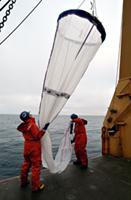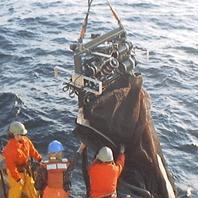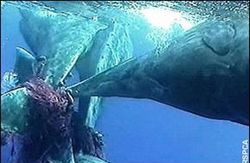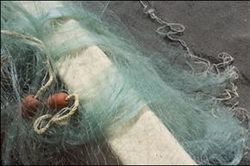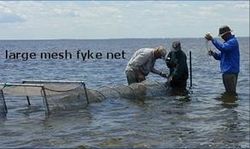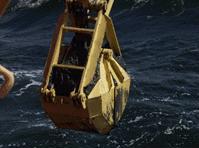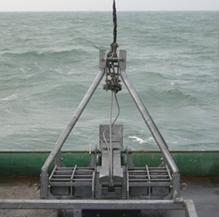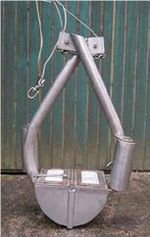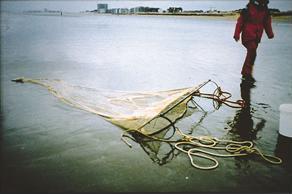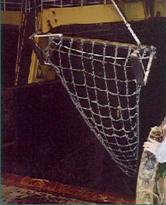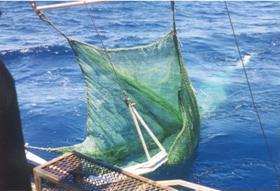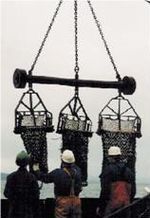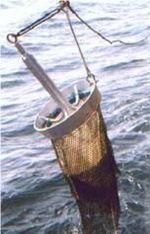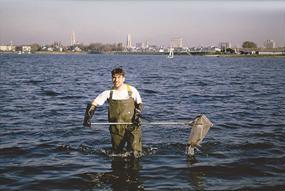Difference between revisions of "Sampling tools for the marine environment"
Dronkers J (talk | contribs) |
|||
| (37 intermediate revisions by 5 users not shown) | |||
| Line 1: | Line 1: | ||
| − | + | ||
| − | |||
This article provides an overview of the sampling tools and fishing techniques used in the marine environment. These relate to species occuring on the sea surface, the water column and on the seabed. | This article provides an overview of the sampling tools and fishing techniques used in the marine environment. These relate to species occuring on the sea surface, the water column and on the seabed. | ||
| − | + | ==Introduction== | |
| + | All methods of physical capture are inherently selective. Small fish may pass through large-meshed nets; large fish may out-swim trawls; gill nets will catch fish mainly of a certain size range. Fish may react differently to fishing gear with respect to species, size, biological state, environmental conditions including ambient light and the acoustic noise field, among many other factors. | ||
<ref>Steele, J.H.; Thorpe, S.A.; Turekian, K.K. (Ed.). (2001). Encyclopedia of ocean sciences. Academic Press: San Diego, CA (USA). 6 vol. p748-749</ref>|This is why organisms are subdivided out of practical necessity, in that the sampling approach and sample size that are appropriate for one group are often inappropriate for another. The disparity in appropriate techniques for different sizes of groups of organisms has contributed greatly to the paucity of studies on more than one taxonomic grouping at a given locale. | <ref>Steele, J.H.; Thorpe, S.A.; Turekian, K.K. (Ed.). (2001). Encyclopedia of ocean sciences. Academic Press: San Diego, CA (USA). 6 vol. p748-749</ref>|This is why organisms are subdivided out of practical necessity, in that the sampling approach and sample size that are appropriate for one group are often inappropriate for another. The disparity in appropriate techniques for different sizes of groups of organisms has contributed greatly to the paucity of studies on more than one taxonomic grouping at a given locale. | ||
| − | Unfortunately, where conflicting conclusions have been drawn patterns in different groups of organisms, it is rarely possible to know whether the patterns truly vary among groups or merely reflect differences in sampling efforts. | + | Unfortunately, where conflicting conclusions have been drawn patterns in different groups of organisms, it is rarely possible to know whether the patterns truly vary among groups or merely reflect differences in sampling efforts. The choice of a suitable sampler is a compromise between a variety of factors. |
| − | |||
| − | The choice of a suitable sampler is a compromise between a variety of factors. | ||
| − | |||
| − | |||
| − | |||
| − | |||
| − | |||
| − | |||
| − | |||
| − | |||
| − | |||
| − | |||
| − | |||
| − | |||
| − | |||
| − | |||
| − | |||
| − | |||
| + | ==Sampling tools for pelagic organisms== | ||
| + | ===Midwater or pelagic trawl=== | ||
| + | [[image: pelagic trawl1.jpg |thumb|left|300px| pelagic trawl]] | ||
| + | [[image: pelagic trawl2.jpg |thumb|right|300px| pelagic trawl]] | ||
| + | A midwater or [[pelagic]] trawl is a set of gear that is used to catch fish that are between the sea surface and bottom, generally staying clear of the bottom. Occasionally, midwater trawls are configured with floats to perform catching in the shallow-surface layer. | ||
| + | A midwater trawl consists of a cone shaped body, normally made of four panels, ending in a codend with lateral wings extending forward from the opening. | ||
| + | Midwater and bottom trawls (see further) have many parts in common, if differing in dimensions and shapes due to their different fishing objects and hydrodynamic regimes of operation. Midwater trawls are designed to catch fish in the midwater column, hence must be capable of rapid maneuvering while maintaining an open net mouth. This is reflected in differences in the body of the net, rigging, and even trawl doors. | ||
| − | == | + | ===Plankton nets=== |
| − | + | [[Plankton]] nets are a modification on the standard trawl used to collect planktonic organisms, of nearly any size, intact. Towed by a research vessel, plankton nets have a long funnel shape that allows them to catch differently sized plankton simply by changing the mesh size of the net. At the end of the funnel is a collection cylinder called a cod-end. | |
===Ring net=== | ===Ring net=== | ||
| − | [[Image:ringnet.jpg| | + | [[Image:ringnet.jpg|thumb|left|150px|ring net]] |
| − | |||
| − | |||
| − | |||
| − | |||
| − | |||
| − | |||
| + | The ring net consists of a fine-meshed bag attached at its mouth, or opening, to a metallic ring. The net itself is terminated in a bottle or jar where the unfiltered plankton and other particulate matter are collected. | ||
| + | The net is usually deployed vertically for non-quantitative purposes from a platform, such as a vessel or [[Piers and trestles|pier]]. It may also be towed, although lacking in devices for controlling its passage through the water column, which is otherwise determined by hydrodynamic forces generated naturally during towing or hauling. Towing applications are mainly non-quantitative. | ||
| + | <br style="clear:both;"/> | ||
===Bongo nets=== | ===Bongo nets=== | ||
| − | [[Image:bongo.jpg|right|bongo nets<ref> | + | [[Image:bongo.jpg|thumb|right|150px|bongo nets<ref> https://oceanexplorer.noaa.gov/explorations/07philippines/logs/oct5/media/bongonets_600.html </ref>]] |
| + | Floating or suspended fish eggs and newly hatched larvae are often caught with Bongo nets. The mesh size is very fine, ranging from 20 µm up to 1000 µm (1 mm), thus allowing eggs and larvae with sizes of order 1-20 mm to be caught. The nets, mounted on a rigid yoke, can be towed from the surface to near the bottom for sampling throughout the water column. | ||
In order to obtain quantitative samples of [[phytoplankton]], [[zooplankton]], other invertebrates, and large fish, it is critical to estimate the volume of water that is filtered during the sample. Most bongo and ring nets are deployed with mechanical or electronic flow meters positioned in the mouth of the net to quantify the volume of water filtered. | In order to obtain quantitative samples of [[phytoplankton]], [[zooplankton]], other invertebrates, and large fish, it is critical to estimate the volume of water that is filtered during the sample. Most bongo and ring nets are deployed with mechanical or electronic flow meters positioned in the mouth of the net to quantify the volume of water filtered. | ||
| + | <br style="clear:both;"/> | ||
| + | ===MOCNESS=== | ||
| + | '''(Multiple Opening/Closing Nets and Environmental Sampling System)''' | ||
| + | [[Image:Mocness.jpg|thumb|left|300px|MOCNESS]] | ||
| + | The Multiple Opening/Closing Nets and Environmental Sampling System, which is generally known by its acronym MOCNESS, is an operational, widely used system for capturing plankton at specific depths on the command of the operator. It also routinely carries a number of sensors for measuring environmental parameters as it is towed. These sensors measure, for example, conductivity, temperature, pressure, [[fluorescence]], optical transmission, dissolved oxygen, and light levels. | ||
| + | ===Neuston nets=== | ||
| + | [[Image:neuston net.jpg|thumb|right|250px|neuston net<ref name= "dnr">http://www.dnr.sc.gov/marine/sertc/sampling%20methods.pdf</ref>]] | ||
| + | These types of nets are towed at the surface to sample [[neuston]]. Neuston are those organisms associated with the water surface, where they are supported by surface tension. Scientist can determine the number of organisms per unit volume of water filtered<ref name= "dnr">http://www.dnr.sc.gov/marine/sertc/sampling%20methods.pdf</ref>. | ||
| + | ===Drift nets=== | ||
| + | [[Image:drift net.jpg|thumb|left|250px|Whales and dolphins have been caught in drift nets.]] | ||
| + | Drift nets are not set or fixed in any way, are in fact ‘mobile’, and they are allowed to drift with the prevailing [[currents]]. Drift nets are used on the high seas for the capture of a wide range of fish including tuna, squid and shark, and off north-east England for salmon | ||
| + | An EU-wide ban on all drift nets was introduced from January 2002 but problems still exist. | ||
| + | ===Gill nets=== | ||
| + | [[Image:gill net.jpg|thumb|right|250px|gill net]] | ||
| + | Gill nets are walls of netting which may be set at or below the surface, on the seabed, or at any depth in between. Gill netting is probably the oldest form of net fishing, having been in use for thousands of years. True gill nets catch fish that attempt to swim through the net, which are caught if they are of a size large enough to allow the head to pass through the meshes but not the rest of the body. The fish then becomes entangled by the gills as it attempts to back out of the net. The mesh size used depends upon the species and size range being targeted <ref>http://www.fao.org/fishery/geartype/107/en</ref>. | ||
| − | |||
| − | |||
| − | |||
| − | + | ===Fyke nets=== | |
| − | + | [[Image:fyke net.jpg|thumb|left|250px|fyke net.]] | |
| − | + | Fish communities in shallow water are sampled using fyke nets. A fyke net is a fish trap. It consists of cylindrical or cone-shaped netting bags mounted on rings or other rigid structures. It has wings or leaders which guide the fish towards the entrance of the bags. The fyke nets are fixed on the bottom by anchors, ballast or stakes <ref>http://www.fao.org/fishery/geartype/226/en</ref>. | |
| − | |||
| − | |||
| − | |||
| − | |||
| − | |||
| − | == | ||
| − | |||
| − | |||
| − | |||
| − | |||
| − | |||
| − | |||
| − | |||
| − | |||
| − | |||
| − | |||
| − | |||
| − | |||
| − | |||
| − | |||
| − | |||
| − | |||
| − | = | ||
| − | [[Image: | ||
| − | |||
| − | |||
| − | |||
| − | |||
| − | |||
| − | |||
| − | |||
| − | |||
| − | |||
| − | |||
| − | |||
| − | |||
| − | |||
| − | |||
| − | |||
| − | |||
| − | |||
| − | |||
| − | |||
| − | |||
| − | |||
| − | |||
| − | |||
| − | |||
| − | |||
| − | |||
| − | |||
| − | |||
| − | |||
| Line 136: | Line 82: | ||
| + | ==Sampling tools for benthic organisms== | ||
| + | The type of gear selected for sampling seabed substrata and the [[benthic]] [[macrofauna]] at aggregate dredging sites is primarily determined by the hardness/ compactness of the substrata. Whilst a wide variety of sampling methods are available, only a small proportion of these have the ability to effectively collect samples from areas of relatively coarse sediments which are characteristic of dredging sites. In certain situations, it may be necessary to use more than one technique in order to sample the full range of benthic organisms present in an area. | ||
| + | ===Bottom Grabs=== | ||
| + | [[Image:grab.jpg|thumb|right|250px|grab]] | ||
| + | Grab sampling is the simple process of bringing up surface [[sediments]] from the seafloor. Once it is launched, the jaws of the grab sampler open and it descends to the seafloor. A spring closes the jaws, and they trap [[sediments]] or loose substrate. The grab sampler is then brought up to the surface where its contents are studied in detail. | ||
| + | <br style="clear:both;"/> | ||
| + | ===Hamon grab=== | ||
| + | [[Image:Hammon grab.jpg|thumb|left|250px|Hammon grab]] | ||
| + | The Hamon grab is the recommended tool for sampling the benthic macro-[[infauna]] from | ||
| + | coarse substrata. This grab consists of a rectangular frame forming a stable support for a sampling bucket attached to a pivoted arm. On reaching the seabed, tension in the wire is released which activates the grab. Tension in the wire during in hauling then moves the pivoted arm through a rotation of 90°, driving the sample bucket through the sediment. At the end of its movement, the bucket locates onto an inclined rubber-covered steel plate, sealing it completely. This results in the [[sediment]] rolling towards the bottom of the sample bucket, thereby reducing the risk of [[gravel]] becoming trapped between the leading edge of the bucket and the sample retaining plate, and thus preventing part of the sample being washed out. Weights are attached to the grab to minimize the lateral movement of the supporting frame during sample collection. A drawback of the Hamon grab is that the [[sediment]] sample is mixed during the process of collection and retrieval, thereby precluding the examination or sub-sampling of an undisturbed sediment surface. | ||
| − | |||
| − | |||
| − | |||
| − | |||
| − | |||
| − | |||
| − | |||
| − | |||
| − | |||
| − | |||
| − | |||
| − | |||
| − | |||
| − | |||
| − | |||
| − | |||
| − | |||
| − | |||
| − | |||
| − | |||
| − | |||
| − | |||
===Van Veen grab=== | ===Van Veen grab=== | ||
| − | [[Image:Van veen grab.jpg|right|Van Veen grab | + | [[Image:Van veen grab.jpg|thumb|right|150px|Van Veen grab]] |
| − | + | The van Veen grab in common with many other grabs, relies on the closure of two opposing jaws for the collection of a [[sediment]] sample. The van Veen grab has long arms attached to each bucket, thus giving better leverage during closure. This mode of action is not ideally suited for the collection of coarse sediments as large particles of gravel tend to become caught between the jaws, resulting in loss of the sample upon retrieval of the grab. Thus, whilst this type of grab has been used widely in [[benthic]] [[macrofauna]] studies, it is not recommended for use on coarser substrata. | |
| + | <br style="clear:both;"/> | ||
| + | ===Bottom Trawl=== | ||
| + | Bottom trawls are commonly used for remotely sampling the [[epifauna]]. They are designed to sample at and just above the surface of the seabed and, because of the relatively large area that can be covered in one deployment, they are appropriate for collecting the larger, rarer or more motile species<ref> http://www.fao.org/fishery/geartype/205/en</ref>. | ||
| + | The design requirements of a bottom trawl are relatively simple, a mechanism for keeping the mouth of the net open in horizontal and vertical dimensions, a "body" of net which guides fish inwards, and a "cod-end" of a suitable mesh size, where the fish are collected. The size and design of net used is determined by the species being targeted, the engine power and design of the fishing vessel and locally enforced regulations. | ||
| + | ===Beam Trawling=== | ||
| + | [[Image:beamtrawl1.jpg|thumb|left|beam trawl]][[Image:beamtrawl2.jpg|thumb|center|beam trawl]] | ||
| + | <br style="clear:both;"/> | ||
| + | The simplest method of bottom trawling, the mouth of the net is held open by a solid metal beam, attached to two "shoes", which are solid metal plates, welded to the ends of the beam, which slide over and disturb the seabed. This method is mainly used on smaller vessels, fishing for flatfish or prawns, relatively close inshore<ref> http://www.fao.org/fishery/geartype/305/en</ref>. | ||
| − | |||
| − | |||
| − | |||
| − | |||
| − | |||
| − | |||
| − | |||
| − | |||
| − | |||
| − | |||
| − | |||
| − | |||
| − | |||
| − | |||
===Otter trawling=== | ===Otter trawling=== | ||
| − | <ref name="trawl"> http://en.wikipedia.org/wiki/Bottom_trawling</ref>Otter trawling derives its name from the "trawl doors" or "otters" which are used to keep the mouth of the net open. As these are towed along the seabed, hydrodynamic pressure pushes them outwards, preventing the mouth of the net closing. They also act like a plough, digging up to 15cm into the seabed, creating a turbid cloud, and scaring fish towards the trawl net mouth. The net is held open vertically on an otter trawl by floats and/or kites attached to the "headline" (the rope which runs along the upper mouth of the net), and weighted "bobbins" attached to the "foot rope" (the rope which runs along the lower mouth of the net). These bobbins vary in their design depending on the roughness of the sea bed which is being fished, varying from small rubber discs for very smooth, sandy ground, to large metal balls, up to 0.5 m in diameter for very rough ground. These bobbins can also be designed to lift the net off the seabed when they hit an obstacle. | + | <ref name="trawl"> http://en.wikipedia.org/wiki/Bottom_trawling</ref>Otter trawling derives its name from the "trawl doors" or "otters" which are used to keep the mouth of the net open. As these are towed along the seabed, [[hydrodynamic]] pressure pushes them outwards, preventing the mouth of the net closing. They also act like a plough, digging up to 15cm into the seabed, creating a turbid cloud, and scaring fish towards the trawl net mouth. The net is held open vertically on an otter trawl by floats and/or kites attached to the "headline" (the rope which runs along the upper mouth of the net), and weighted "bobbins" attached to the "foot rope" (the rope which runs along the lower mouth of the net). These bobbins vary in their design depending on the roughness of the sea bed which is being fished, varying from small rubber discs for very smooth, sandy ground, to large metal balls, up to 0.5 m in diameter for very rough ground. These bobbins can also be designed to lift the net off the seabed when they hit an obstacle. |
| − | These trawls are commonly used to collect organisms from a sandy bottom | + | These trawls are commonly used to collect organisms from a sandy bottom<ref>http://www.fao.org/fishery/geartype/306/en</ref>. |
| − | |||
| − | |||
| − | |||
| − | |||
| − | |||
| − | |||
| − | |||
| − | |||
| − | |||
| − | |||
| − | |||
| − | |||
| − | |||
| − | |||
| − | |||
| + | [[Image:ottertrawl.jpg|thumb|left|otter trawl]] [[Image:ottertrawl2.jpg|thumb|center|otter trawl]] | ||
| + | <br style="clear:both;"/> | ||
===Shrimp trawling=== | ===Shrimp trawling=== | ||
| − | [[Image:shrimptrawl.jpg| | + | [[Image:shrimptrawl.jpg|thumb|left|150px|shrimp trawl<ref>http://www.ucs.louisiana.edu/~rtb6933/shrimp/penaeid.html</ref>]] |
| − | |||
| − | |||
| − | |||
| − | |||
| − | |||
| − | |||
| − | |||
| − | |||
| − | |||
| − | |||
| − | |||
| − | |||
| − | |||
| − | |||
| − | |||
| − | |||
| − | |||
| − | |||
| − | |||
| − | |||
| + | A special small-mesh bottom trawl is used to catch northern shrimp. This follows the basic design of the otter trawl, but with modified shape and dimensions. The groundrope and sweep are configured to optimize the capture of shrimp. | ||
| + | <br style="clear:both;"/> | ||
==[[Dredging|Dredges]]== | ==[[Dredging|Dredges]]== | ||
| − | + | In general, the use of towed dredges for evaluation of epifaunal community structure should be avoided when other sampling tools (e.g. beam trawls) can be effectively employed. However, where the hard or uneven nature of the substrata precludes the use of a trawl it is often possible to obtain adequate samples using dredges, a variety of which are available | |
===Newhaven Scallop dredge=== | ===Newhaven Scallop dredge=== | ||
| − | [[Image:Newhaven Scallop dredge .jpg|right|Newhaven Scallop dredge | + | [[Image:Newhaven Scallop dredge .jpg|thumb|right|150px|Newhaven Scallop dredge]] |
| − | + | The Newhaven Scallop dredge is a commercially-used towed device that may be operated over very coarse terrain but would be likely to suffer damage if towed over bedrock or through large [[boulders]]. The dredge itself consists of a triangular steel frame supporting, on its underside, a spring-loaded plate to which a tooth bar, designed to dig into the sediment, is bolted. When the dredge encounters rock or large stones, the springs allow the tooth-bar to swing back thus avoiding snagging and reducing the quantity of stones caught. Also attached to each frame is a bag whose lower surface is made up of heavy-duty metal links with an upper surface of heavy gauge nylon mesh. The maximum diameter of particle likely to be retained within the dredge is approximately 20 mm. A number of these dredges may be attached to a robust metal beam which is fitted with large rubber rollers at each end. | |
| − | The dredges are deployed over the stern or side of a vessel and towed for a pre-determined time. Care must be taken to ensure that the dredge is deployed the right way up. The sampling efficiency of the dredge for each tow can be assessed on deck, normally by the quantity of material collected . The use of this device is recommended for the collection of qualitative samples as a last resort in areas of coarse, unconsolidated sediments which are too rough or uneven to permit the deployment of less robust gear. The Scallop dredge may be used to test the suitability of the ground prior to the deployment of less robust gear (e.g. beam trawl). This may be particularly useful if the ground is thought to be very coarse or uneven. | + | The dredges are deployed over the stern or side of a vessel and towed for a pre-determined time. Care must be taken to ensure that the dredge is deployed the right way up. The sampling efficiency of the dredge for each tow can be assessed on deck, normally by the quantity of material collected . The use of this device is recommended for the collection of qualitative samples as a last resort in areas of coarse, unconsolidated sediments which are too rough or uneven to permit the deployment of less robust gear. The Scallop dredge may be used to test the suitability of the ground prior to the deployment of less robust gear (e.g. beam trawl). This may be particularly useful if the ground is thought to be very coarse or uneven<ref> https://seafish.org/gear-database/gear/queen-scallop-dredge/</ref>. |
===Rallier-du-bathy dredge=== | ===Rallier-du-bathy dredge=== | ||
| − | [[Image:RBdredge.jpg| | + | [[Image:RBdredge.jpg|thumb|left|150px|Rallier-du-bathy dredge]] |
| − | |||
| − | |||
| − | |||
| − | |||
| − | |||
| − | |||
| − | |||
| − | |||
| − | |||
| − | |||
| − | |||
| − | |||
| + | The Raillier-du-Baty dredge is designed to work in a range of substrata from [[sand]]s to [[cobbles]]. It consists of a robust metal ring attached to a central towing arm. An open ended bag of the desired mesh size is attached to the ring, and the trailing end of the bag is tied to prevent loss of material during collection of the sample. This inner bag is protected by an outer, coarser bag which is, in turn, enclosed by a heavy duty apron of fishing net, in order to reduce chafing. The warp is attached to a fixing point on the metal ring, and a weak link is placed between this point and the central arm. This optimizes the digging capability of the edge of the ring and reduces the chances of the edge being lifted away from the seabed<ref> https://www.ices.dk/sites/pub/Publication%20Reports/Techniques%20in%20Marine%20Environmental%20Sciences%20(TIMES)/TIMES42.pdf</ref>. | ||
| + | <br style="clear:both;"/> | ||
==Corers== | ==Corers== | ||
| Line 269: | Line 156: | ||
===The gravity corer=== | ===The gravity corer=== | ||
| − | [[Image:gravcorer.jpg|right|gravity corer | + | [[Image:gravcorer.jpg|thumb|right|200px|gravity corer]] |
| − | |||
| − | |||
| − | |||
| + | Gravity corers are widely used for the collection of the smallest marine metazoans ([[meiofauna]]) from [[subtidal]] grounds. | ||
| + | The gravity corer is basically a weighted tube mounted within a frame that descends by gravity from the research vessel to the sea floor, where it penetrates the [[sediment]] to a given depth, filling the tube with [[sediment]] in the process. The hydraulically-damped gravity corer has a slow rate of penetration that is controlled by a water-filled piston. Disturbance of the water-sediment interface is minimal and maximum penetration in [[mud]] is about 70 cm. A core-catcher on the bottom of the tube moves into place when retrieval begins, trapping the [[sediment]] sample in the corer. A winch, onboard the ship, slowly brings the corer back to the surface<ref> https://www.whoi.edu/what-we-do/explore/instruments/instruments-sensors-samplers/gravity-corer/ </ref>|. | ||
| + | ===Multiple corer=== | ||
| + | [[Image:Multipele corer.jpg|thumb|left|150px|multiple corer]] | ||
| − | |||
| − | |||
To test local faunal variations, it is necessary to recover several discrete samples from a single station. The samples could be obtained by multiple casts with a single [[core]] tube, but this approach requires much valuable ship time. A multiple corer incorporates the separate coring tubes into a single [[core]] body. | To test local faunal variations, it is necessary to recover several discrete samples from a single station. The samples could be obtained by multiple casts with a single [[core]] tube, but this approach requires much valuable ship time. A multiple corer incorporates the separate coring tubes into a single [[core]] body. | ||
| − | It consists of a system to which a series of tubes measuring about 4 cm in diameter are attached. Above the system, a weight is mounted and this falls down onto the assembly system when the multicorer touches the sediment. The falling weight drives the tubes into the sea bed so that when they are raised again each of them contains a drilling [[core]] with sediment from the sea floor. When studying the benthic communities, scientists then take account of the depth at which these tiny creatures were found below the sea floor. | + | It consists of a system to which a series of tubes measuring about 4 cm in diameter are attached. Above the system, a weight is mounted and this falls down onto the assembly system when the multicorer touches the sediment. The falling weight drives the tubes into the sea bed so that when they are raised again each of them contains a drilling [[core]] with [[sediment]] from the sea floor. When studying the benthic communities, scientists then take account of the depth at which these tiny creatures were found below the sea floor. |
| − | + | <br style="clear:both;"/> | |
| − | |||
| − | |||
| − | |||
| − | |||
| − | |||
| − | |||
| − | |||
===Reineck boxcorer=== | ===Reineck boxcorer=== | ||
| − | [[Image:reineck.jpg|right|Reineck boxcorer | + | [[Image:reineck.jpg|thumb|right|300px|Reineck boxcorer]] |
| − | + | The boxcorer takes relatively undisturbed samples. The equipment operates by a self releasing trigger system triggered by the frame touching the sea bed. The square box is pushed into the bottom by gravity force of the weight mounted on the top of the box retainer. A spade freed by the trigger-mechanism closes the sample box during the recovery of the unit preventing the sample being washed-out<ref> http://www.vliz.be/en/reineckboxcorer-en</ref>. | |
| − | + | <br style="clear:both;"/> | |
| − | |||
| − | |||
| − | |||
| − | |||
| − | |||
| − | |||
| − | |||
| − | |||
| − | |||
| − | |||
===Multi boxcorer=== | ===Multi boxcorer=== | ||
| − | [[Image:multiboxcorer.jpg| | + | [[Image:multiboxcorer.jpg|thumb|left|300px|multi boxcorer]] |
A multi boxcorer incorporates the separate coring tubes of a boxcorer into a single core body. | A multi boxcorer incorporates the separate coring tubes of a boxcorer into a single core body. | ||
| + | <br style="clear:both;"/> | ||
| + | ==Hyperbenthos sledge== | ||
| + | The [[benthic]] carriage drags a net over the sea floor. This net is divided into various compartments one above the other so that the [[benthic]] communities can be collected whether they are close to or further away from the sea floor<ref> http://www.vliz.be/en/hyperbenthicsledge</ref>. | ||
| + | [[Image:sledge2.jpg|thumb|left|hyperbenthos sledge]] | ||
| + | [[Image:sledge1.jpg|thumb|center|hyperbenthos sledge]] | ||
| + | <br style="clear:both;"/> | ||
| − | + | ==Hyperbenthos net== | |
| − | |||
| − | |||
| − | |||
| − | |||
| − | |||
| − | |||
| − | |||
| − | |||
| − | |||
| − | |||
| − | |||
| − | |||
| − | |||
| − | |||
| − | == | ||
| − | |||
| − | |||
| − | |||
| − | |||
| − | |||
| − | |||
| − | |||
| − | |||
| − | |||
| − | [[Image:hyperbenthos net.jpg| | + | [[Image:hyperbenthos net.jpg|thumb|left|300px|hyperbenthos net]] |
| − | The hyperbenthos net is used for the collection of hyperbenthos. | + | The [[hyperbenthos]] net is used for the collection of hyperbenthos. |
| − | + | <br style="clear:both;"/> | |
| − | |||
| − | |||
| − | |||
| − | |||
| + | ==References== | ||
| + | <references/> | ||
| + | ==See also== | ||
| + | ===Internal links=== | ||
| + | [[Instruments and sensors to measure environmental parameters]] | ||
| + | ===External links=== | ||
| + | :[https://www.ices.dk/sites/pub/Publication%20Reports/Techniques%20in%20Marine%20Environmental%20Sciences%20(TIMES)/TIMES42.pdf Guidelines for the study of the epibenthos of subtidal environments] | ||
| + | :[https://www.ices.dk/sites/pub/Publication%20Reports/Techniques%20in%20Marine%20Environmental%20Sciences%20(TIMES)/TIMES27.pdf ICES Techniques in Marine Environmental Sciences No. 27 Soft bottom macrofauna:Collection, treatment, and quality assurance of samples] | ||
| + | :[https://www.ices.dk/sites/pub/Publication%20Reports/Techniques%20in%20Marine%20Environmental%20Sciences%20(TIMES)/TIMES32.pdf ICES Techniques in Marine Environmental Sciences No. 32 Biological monitoring: General guidelines for quality assurance] | ||
| − | |||
| − | |||
| − | |||
| − | |||
| − | |||
| − | |||
| − | |||
| − | |||
| − | |||
| − | |||
| − | |||
| − | |||
| − | |||
| − | |||
{{author | {{author | ||
|AuthorID=15335 | |AuthorID=15335 | ||
|AuthorFullName=Sohier, Charlotte | |AuthorFullName=Sohier, Charlotte | ||
|AuthorName=Charlotte}} | |AuthorName=Charlotte}} | ||
| − | [[Category: | + | |
| + | [[Category:Coastal and marine observation and monitoring]] | ||
| + | [[Category:Observation of biological parameters]] | ||
| + | [[Category:Coastal and marine fisheries]] | ||
| + | [[Category:Coastal and marine ecosystems]] | ||
Latest revision as of 21:24, 20 August 2020
This article provides an overview of the sampling tools and fishing techniques used in the marine environment. These relate to species occuring on the sea surface, the water column and on the seabed.
Contents
Introduction
All methods of physical capture are inherently selective. Small fish may pass through large-meshed nets; large fish may out-swim trawls; gill nets will catch fish mainly of a certain size range. Fish may react differently to fishing gear with respect to species, size, biological state, environmental conditions including ambient light and the acoustic noise field, among many other factors.
[1]|This is why organisms are subdivided out of practical necessity, in that the sampling approach and sample size that are appropriate for one group are often inappropriate for another. The disparity in appropriate techniques for different sizes of groups of organisms has contributed greatly to the paucity of studies on more than one taxonomic grouping at a given locale.
Unfortunately, where conflicting conclusions have been drawn patterns in different groups of organisms, it is rarely possible to know whether the patterns truly vary among groups or merely reflect differences in sampling efforts. The choice of a suitable sampler is a compromise between a variety of factors.
Sampling tools for pelagic organisms
Midwater or pelagic trawl
A midwater or pelagic trawl is a set of gear that is used to catch fish that are between the sea surface and bottom, generally staying clear of the bottom. Occasionally, midwater trawls are configured with floats to perform catching in the shallow-surface layer.
A midwater trawl consists of a cone shaped body, normally made of four panels, ending in a codend with lateral wings extending forward from the opening.
Midwater and bottom trawls (see further) have many parts in common, if differing in dimensions and shapes due to their different fishing objects and hydrodynamic regimes of operation. Midwater trawls are designed to catch fish in the midwater column, hence must be capable of rapid maneuvering while maintaining an open net mouth. This is reflected in differences in the body of the net, rigging, and even trawl doors.
Plankton nets
Plankton nets are a modification on the standard trawl used to collect planktonic organisms, of nearly any size, intact. Towed by a research vessel, plankton nets have a long funnel shape that allows them to catch differently sized plankton simply by changing the mesh size of the net. At the end of the funnel is a collection cylinder called a cod-end.
Ring net
The ring net consists of a fine-meshed bag attached at its mouth, or opening, to a metallic ring. The net itself is terminated in a bottle or jar where the unfiltered plankton and other particulate matter are collected.
The net is usually deployed vertically for non-quantitative purposes from a platform, such as a vessel or pier. It may also be towed, although lacking in devices for controlling its passage through the water column, which is otherwise determined by hydrodynamic forces generated naturally during towing or hauling. Towing applications are mainly non-quantitative.
Bongo nets
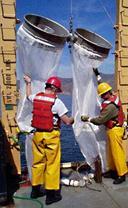
Floating or suspended fish eggs and newly hatched larvae are often caught with Bongo nets. The mesh size is very fine, ranging from 20 µm up to 1000 µm (1 mm), thus allowing eggs and larvae with sizes of order 1-20 mm to be caught. The nets, mounted on a rigid yoke, can be towed from the surface to near the bottom for sampling throughout the water column.
In order to obtain quantitative samples of phytoplankton, zooplankton, other invertebrates, and large fish, it is critical to estimate the volume of water that is filtered during the sample. Most bongo and ring nets are deployed with mechanical or electronic flow meters positioned in the mouth of the net to quantify the volume of water filtered.
MOCNESS
(Multiple Opening/Closing Nets and Environmental Sampling System)
The Multiple Opening/Closing Nets and Environmental Sampling System, which is generally known by its acronym MOCNESS, is an operational, widely used system for capturing plankton at specific depths on the command of the operator. It also routinely carries a number of sensors for measuring environmental parameters as it is towed. These sensors measure, for example, conductivity, temperature, pressure, fluorescence, optical transmission, dissolved oxygen, and light levels.
Neuston nets
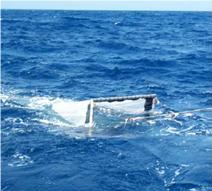
These types of nets are towed at the surface to sample neuston. Neuston are those organisms associated with the water surface, where they are supported by surface tension. Scientist can determine the number of organisms per unit volume of water filtered[3].
Drift nets
Drift nets are not set or fixed in any way, are in fact ‘mobile’, and they are allowed to drift with the prevailing currents. Drift nets are used on the high seas for the capture of a wide range of fish including tuna, squid and shark, and off north-east England for salmon An EU-wide ban on all drift nets was introduced from January 2002 but problems still exist.
Gill nets
Gill nets are walls of netting which may be set at or below the surface, on the seabed, or at any depth in between. Gill netting is probably the oldest form of net fishing, having been in use for thousands of years. True gill nets catch fish that attempt to swim through the net, which are caught if they are of a size large enough to allow the head to pass through the meshes but not the rest of the body. The fish then becomes entangled by the gills as it attempts to back out of the net. The mesh size used depends upon the species and size range being targeted [4].
Fyke nets
Fish communities in shallow water are sampled using fyke nets. A fyke net is a fish trap. It consists of cylindrical or cone-shaped netting bags mounted on rings or other rigid structures. It has wings or leaders which guide the fish towards the entrance of the bags. The fyke nets are fixed on the bottom by anchors, ballast or stakes [5].
Sampling tools for benthic organisms
The type of gear selected for sampling seabed substrata and the benthic macrofauna at aggregate dredging sites is primarily determined by the hardness/ compactness of the substrata. Whilst a wide variety of sampling methods are available, only a small proportion of these have the ability to effectively collect samples from areas of relatively coarse sediments which are characteristic of dredging sites. In certain situations, it may be necessary to use more than one technique in order to sample the full range of benthic organisms present in an area.
Bottom Grabs
Grab sampling is the simple process of bringing up surface sediments from the seafloor. Once it is launched, the jaws of the grab sampler open and it descends to the seafloor. A spring closes the jaws, and they trap sediments or loose substrate. The grab sampler is then brought up to the surface where its contents are studied in detail.
Hamon grab
The Hamon grab is the recommended tool for sampling the benthic macro-infauna from coarse substrata. This grab consists of a rectangular frame forming a stable support for a sampling bucket attached to a pivoted arm. On reaching the seabed, tension in the wire is released which activates the grab. Tension in the wire during in hauling then moves the pivoted arm through a rotation of 90°, driving the sample bucket through the sediment. At the end of its movement, the bucket locates onto an inclined rubber-covered steel plate, sealing it completely. This results in the sediment rolling towards the bottom of the sample bucket, thereby reducing the risk of gravel becoming trapped between the leading edge of the bucket and the sample retaining plate, and thus preventing part of the sample being washed out. Weights are attached to the grab to minimize the lateral movement of the supporting frame during sample collection. A drawback of the Hamon grab is that the sediment sample is mixed during the process of collection and retrieval, thereby precluding the examination or sub-sampling of an undisturbed sediment surface.
Van Veen grab
The van Veen grab in common with many other grabs, relies on the closure of two opposing jaws for the collection of a sediment sample. The van Veen grab has long arms attached to each bucket, thus giving better leverage during closure. This mode of action is not ideally suited for the collection of coarse sediments as large particles of gravel tend to become caught between the jaws, resulting in loss of the sample upon retrieval of the grab. Thus, whilst this type of grab has been used widely in benthic macrofauna studies, it is not recommended for use on coarser substrata.
Bottom Trawl
Bottom trawls are commonly used for remotely sampling the epifauna. They are designed to sample at and just above the surface of the seabed and, because of the relatively large area that can be covered in one deployment, they are appropriate for collecting the larger, rarer or more motile species[6].
The design requirements of a bottom trawl are relatively simple, a mechanism for keeping the mouth of the net open in horizontal and vertical dimensions, a "body" of net which guides fish inwards, and a "cod-end" of a suitable mesh size, where the fish are collected. The size and design of net used is determined by the species being targeted, the engine power and design of the fishing vessel and locally enforced regulations.
Beam Trawling
The simplest method of bottom trawling, the mouth of the net is held open by a solid metal beam, attached to two "shoes", which are solid metal plates, welded to the ends of the beam, which slide over and disturb the seabed. This method is mainly used on smaller vessels, fishing for flatfish or prawns, relatively close inshore[7].
Otter trawling
[8]Otter trawling derives its name from the "trawl doors" or "otters" which are used to keep the mouth of the net open. As these are towed along the seabed, hydrodynamic pressure pushes them outwards, preventing the mouth of the net closing. They also act like a plough, digging up to 15cm into the seabed, creating a turbid cloud, and scaring fish towards the trawl net mouth. The net is held open vertically on an otter trawl by floats and/or kites attached to the "headline" (the rope which runs along the upper mouth of the net), and weighted "bobbins" attached to the "foot rope" (the rope which runs along the lower mouth of the net). These bobbins vary in their design depending on the roughness of the sea bed which is being fished, varying from small rubber discs for very smooth, sandy ground, to large metal balls, up to 0.5 m in diameter for very rough ground. These bobbins can also be designed to lift the net off the seabed when they hit an obstacle. These trawls are commonly used to collect organisms from a sandy bottom[9].
Shrimp trawling

A special small-mesh bottom trawl is used to catch northern shrimp. This follows the basic design of the otter trawl, but with modified shape and dimensions. The groundrope and sweep are configured to optimize the capture of shrimp.
Dredges
In general, the use of towed dredges for evaluation of epifaunal community structure should be avoided when other sampling tools (e.g. beam trawls) can be effectively employed. However, where the hard or uneven nature of the substrata precludes the use of a trawl it is often possible to obtain adequate samples using dredges, a variety of which are available
Newhaven Scallop dredge
The Newhaven Scallop dredge is a commercially-used towed device that may be operated over very coarse terrain but would be likely to suffer damage if towed over bedrock or through large boulders. The dredge itself consists of a triangular steel frame supporting, on its underside, a spring-loaded plate to which a tooth bar, designed to dig into the sediment, is bolted. When the dredge encounters rock or large stones, the springs allow the tooth-bar to swing back thus avoiding snagging and reducing the quantity of stones caught. Also attached to each frame is a bag whose lower surface is made up of heavy-duty metal links with an upper surface of heavy gauge nylon mesh. The maximum diameter of particle likely to be retained within the dredge is approximately 20 mm. A number of these dredges may be attached to a robust metal beam which is fitted with large rubber rollers at each end.
The dredges are deployed over the stern or side of a vessel and towed for a pre-determined time. Care must be taken to ensure that the dredge is deployed the right way up. The sampling efficiency of the dredge for each tow can be assessed on deck, normally by the quantity of material collected . The use of this device is recommended for the collection of qualitative samples as a last resort in areas of coarse, unconsolidated sediments which are too rough or uneven to permit the deployment of less robust gear. The Scallop dredge may be used to test the suitability of the ground prior to the deployment of less robust gear (e.g. beam trawl). This may be particularly useful if the ground is thought to be very coarse or uneven[11].
Rallier-du-bathy dredge
The Raillier-du-Baty dredge is designed to work in a range of substrata from sands to cobbles. It consists of a robust metal ring attached to a central towing arm. An open ended bag of the desired mesh size is attached to the ring, and the trailing end of the bag is tied to prevent loss of material during collection of the sample. This inner bag is protected by an outer, coarser bag which is, in turn, enclosed by a heavy duty apron of fishing net, in order to reduce chafing. The warp is attached to a fixing point on the metal ring, and a weak link is placed between this point and the central arm. This optimizes the digging capability of the edge of the ring and reduces the chances of the edge being lifted away from the seabed[12].
Corers
Corers work by boring a large tube into the benthos and then bringing up a column, or core, of sediment intact within the tube. Caps can automatically seal off the ends of the core after it has pulled up a sample, protecting the sample and keeping it intact. Different sizes and approaches work with different organisms and sediment types.
The gravity corer
Gravity corers are widely used for the collection of the smallest marine metazoans (meiofauna) from subtidal grounds.
The gravity corer is basically a weighted tube mounted within a frame that descends by gravity from the research vessel to the sea floor, where it penetrates the sediment to a given depth, filling the tube with sediment in the process. The hydraulically-damped gravity corer has a slow rate of penetration that is controlled by a water-filled piston. Disturbance of the water-sediment interface is minimal and maximum penetration in mud is about 70 cm. A core-catcher on the bottom of the tube moves into place when retrieval begins, trapping the sediment sample in the corer. A winch, onboard the ship, slowly brings the corer back to the surface[13]|.
Multiple corer
To test local faunal variations, it is necessary to recover several discrete samples from a single station. The samples could be obtained by multiple casts with a single core tube, but this approach requires much valuable ship time. A multiple corer incorporates the separate coring tubes into a single core body.
It consists of a system to which a series of tubes measuring about 4 cm in diameter are attached. Above the system, a weight is mounted and this falls down onto the assembly system when the multicorer touches the sediment. The falling weight drives the tubes into the sea bed so that when they are raised again each of them contains a drilling core with sediment from the sea floor. When studying the benthic communities, scientists then take account of the depth at which these tiny creatures were found below the sea floor.
Reineck boxcorer
The boxcorer takes relatively undisturbed samples. The equipment operates by a self releasing trigger system triggered by the frame touching the sea bed. The square box is pushed into the bottom by gravity force of the weight mounted on the top of the box retainer. A spade freed by the trigger-mechanism closes the sample box during the recovery of the unit preventing the sample being washed-out[14].
Multi boxcorer
A multi boxcorer incorporates the separate coring tubes of a boxcorer into a single core body.
Hyperbenthos sledge
The benthic carriage drags a net over the sea floor. This net is divided into various compartments one above the other so that the benthic communities can be collected whether they are close to or further away from the sea floor[15].
Hyperbenthos net
The hyperbenthos net is used for the collection of hyperbenthos.
References
- ↑ Steele, J.H.; Thorpe, S.A.; Turekian, K.K. (Ed.). (2001). Encyclopedia of ocean sciences. Academic Press: San Diego, CA (USA). 6 vol. p748-749
- ↑ https://oceanexplorer.noaa.gov/explorations/07philippines/logs/oct5/media/bongonets_600.html
- ↑ 3.0 3.1 http://www.dnr.sc.gov/marine/sertc/sampling%20methods.pdf
- ↑ http://www.fao.org/fishery/geartype/107/en
- ↑ http://www.fao.org/fishery/geartype/226/en
- ↑ http://www.fao.org/fishery/geartype/205/en
- ↑ http://www.fao.org/fishery/geartype/305/en
- ↑ http://en.wikipedia.org/wiki/Bottom_trawling
- ↑ http://www.fao.org/fishery/geartype/306/en
- ↑ http://www.ucs.louisiana.edu/~rtb6933/shrimp/penaeid.html
- ↑ https://seafish.org/gear-database/gear/queen-scallop-dredge/
- ↑ https://www.ices.dk/sites/pub/Publication%20Reports/Techniques%20in%20Marine%20Environmental%20Sciences%20(TIMES)/TIMES42.pdf
- ↑ https://www.whoi.edu/what-we-do/explore/instruments/instruments-sensors-samplers/gravity-corer/
- ↑ http://www.vliz.be/en/reineckboxcorer-en
- ↑ http://www.vliz.be/en/hyperbenthicsledge
See also
Internal links
Instruments and sensors to measure environmental parameters
External links
- Guidelines for the study of the epibenthos of subtidal environments
- ICES Techniques in Marine Environmental Sciences No. 27 Soft bottom macrofauna:Collection, treatment, and quality assurance of samples
- ICES Techniques in Marine Environmental Sciences No. 32 Biological monitoring: General guidelines for quality assurance
Please note that others may also have edited the contents of this article.
|


